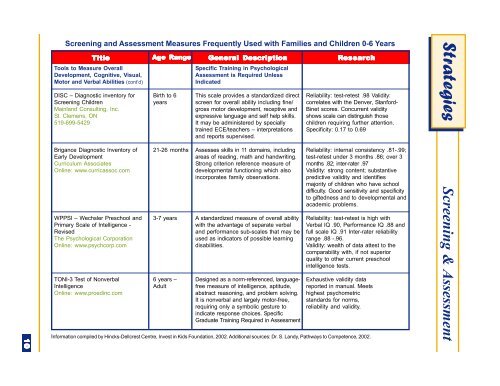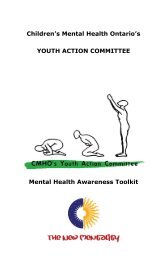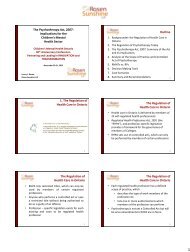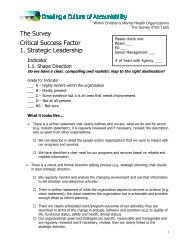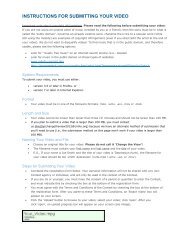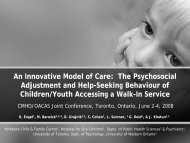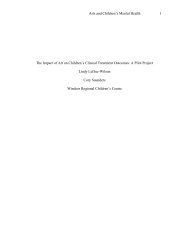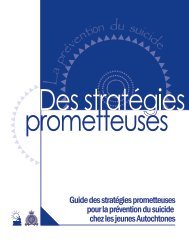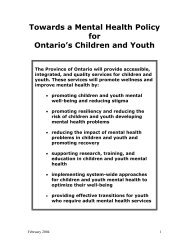Early Childhood Mental Health Treatment: Training Reference Guide
Early Childhood Mental Health Treatment: Training Reference Guide
Early Childhood Mental Health Treatment: Training Reference Guide
You also want an ePaper? Increase the reach of your titles
YUMPU automatically turns print PDFs into web optimized ePapers that Google loves.
10<br />
Screening and Assessment Measures Frequently Used with Families and Children 0-6 Years<br />
Title<br />
Tools to Measure Overall<br />
Development, Cognitive, Visual,<br />
Motor and Verbal Abilities (cont’d)<br />
DISC – Diagnostic inventory for<br />
Screening Children<br />
Mainland Consulting, Inc.<br />
St. Clemens, ON<br />
519-699-5429<br />
Brigance Diagnostic Inventory of<br />
<strong>Early</strong> Development<br />
Curriculum Associates<br />
Online: www.curricassoc.com<br />
WPPSI – Wechsler Preschool and<br />
Primary Scale of Intelligence -<br />
Revised<br />
The Psychological Corporation<br />
Online: www.psychcorp.com<br />
TONI-3 Test of Nonverbal<br />
Intelligence<br />
Online: www.proedinc.com<br />
Age Range<br />
Birth to 6<br />
years<br />
21-26 months<br />
3-7 years<br />
6 years –<br />
Adult<br />
General Description<br />
Specific <strong>Training</strong> in Psychological<br />
Assessment is Required Unless<br />
Indicated<br />
This scale provides a standardized direct<br />
screen for overall ability including fine/<br />
gross motor development, receptive and<br />
expressive language and self help skills.<br />
It may be administered by specially<br />
trained ECE/teachers – interpretations<br />
and reports supervised.<br />
Assesses skills in 11 domains, including<br />
areas of reading, math and handwriting.<br />
Strong criterion reference measure of<br />
developmental functioning which also<br />
incorporates family observations.<br />
A standardized measure of overall ability<br />
with the advantage of separate verbal<br />
and performance sub-scales that may be<br />
used as indicators of possible learning<br />
disabilities.<br />
Designed as a norm-referenced, languagefree<br />
measure of intelligence, aptitude,<br />
abstract reasoning, and problem solving.<br />
It is nonverbal and largely motor-free,<br />
requiring only a symbolic gesture to<br />
indicate response choices. Specific<br />
Graduate <strong>Training</strong> Required in Assessment<br />
Resear<br />
esearch<br />
Reliability: test-retest .98 Validity:<br />
correlates with the Denver, Stanford-<br />
Binet scores. Concurrent validity<br />
shows scale can distinguish those<br />
children requiring further attention.<br />
Specificity: 0.17 to 0.69<br />
Reliability: internal consistency .81-.99;<br />
test-retest under 3 months .86; over 3<br />
months .82; inter-rater .97<br />
Validity: strong content; substantive<br />
predictive validity and identifies<br />
majority of children who have school<br />
difficulty. Good sensitivity and specificity<br />
to giftedness and to developmental and<br />
academic problems.<br />
Reliability: test-retest is high with<br />
Verbal IQ .90, Performance IQ .88 and<br />
full scale IQ .91 Inter-rater reliability<br />
range .88 -.96.<br />
Validity: wealth of data attest to the<br />
comparability with, if not superior<br />
quality to other current preschool<br />
intelligence tests.<br />
Exhaustive validity data<br />
reported in manual. Meets<br />
highest psychometric<br />
standards for norms,<br />
reliability and validity.<br />
Information compiled by Hincks-Dellcrest Centre, Invest in Kids Foundation, 2002. Additional sources: Dr. S. Landy, Pathways to Competence, 2002.<br />
Strategies Screening & Assessment


